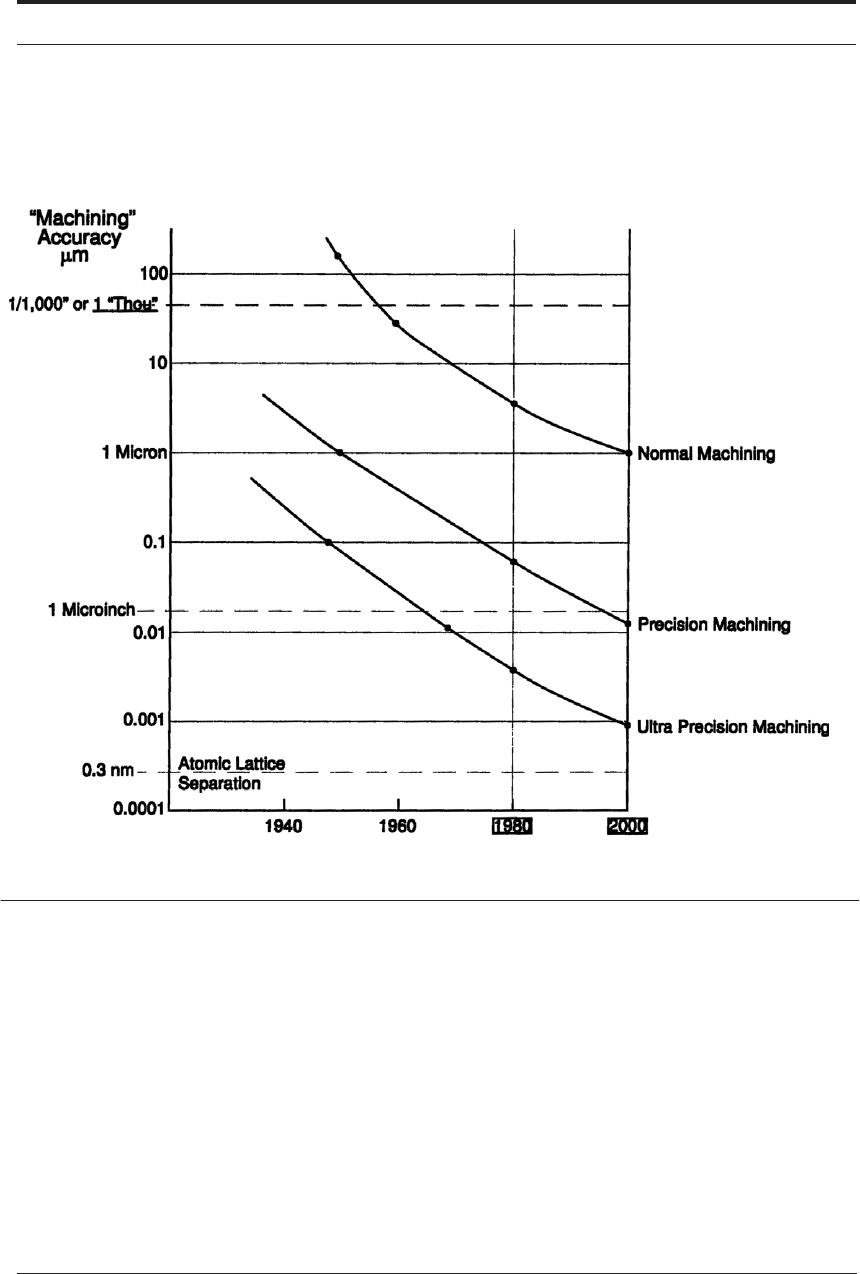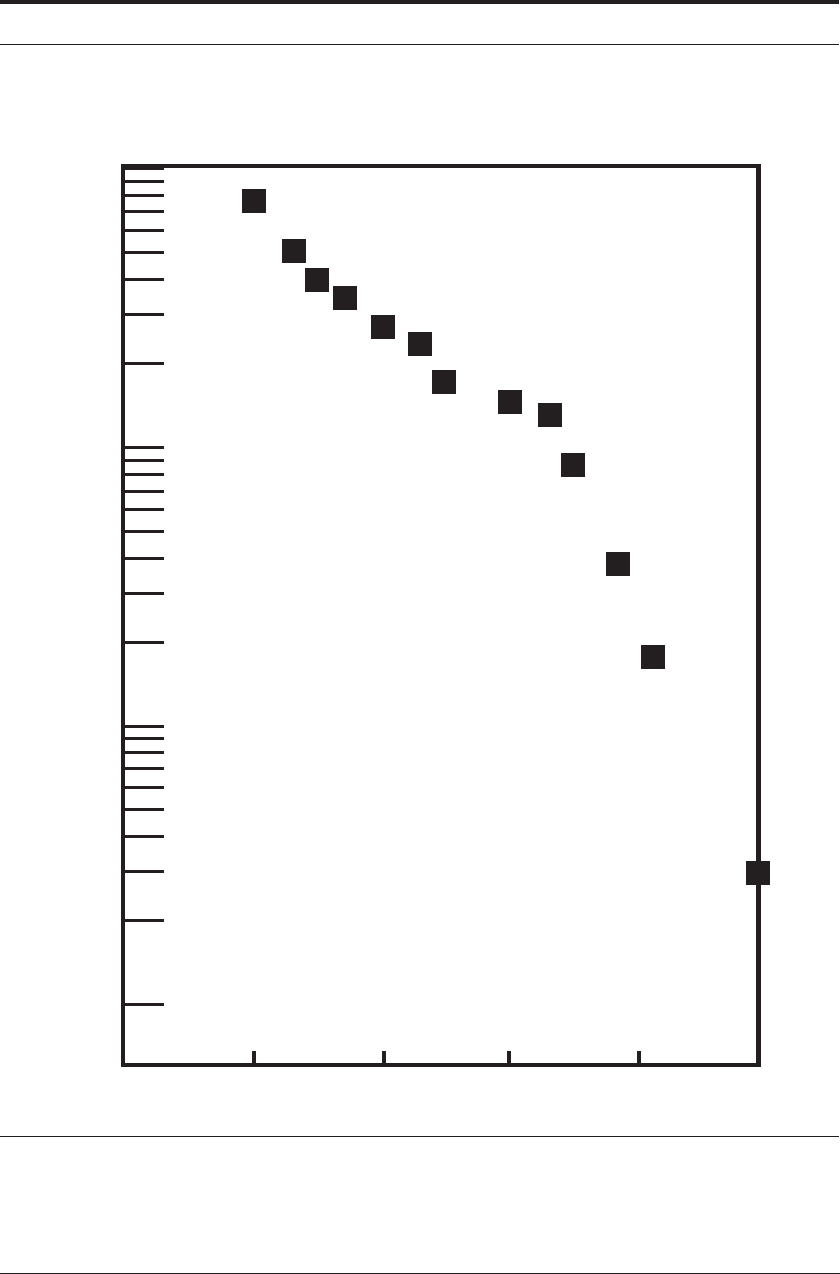Trent E.M., Wright P.K. Metal Cutting
Подождите немного. Документ загружается.


MANAGEMENT OF TECHNOLOGY 413
50%, no matter how good the performance is. In many markets, especially large mature mar-
kets, the proponents of “better” technologies are frustrated in their substitution attempts, even if
the price increase is only 10%.
There are many reasons for user reluctance. Occasionally, the purchasing department is out-
of-touch with the factory floor and there is a fixed budget for tooling. But most often, the CNC
programmers, set-up engineers and operators have been disappointed before by new substitu-
tion tooling aiming to replace the already reliable cemented carbides. In the past they may have
found that the increased expense of a ceramic or diamond tool is not justified by the overall per-
formance as measured by “part-throughput”. And needless to say, if only one or two cata-
strophic failures have been experienced from a new tool material, the staff will be extremely
wary. As described at the end of Chapter 8, this explains why the “rather old-fashioned” high
speed steel is still a stalwart performer and still capturing over one billion dollars a year in U.S.
sales - about half of the market share in the total of 2.5 billion dollars of tool materials (see -
Table 8.3).
The conclusion to be drawn is that, as good as ceramics and CVD-diamond might be, to gain
market share, they probably need to cost no more than 10% more than cemented carbide. Thus,
to enjoy more widespread commercial success, the cost of CVD diamond must be reduced by
several orders of magnitude. In their review, Busch and Dismukes
1
indicate that the DC Arc-Jet
deposition method is likely to be the most effective CVD process if measured by deposition
cost per square. Butler and Windischmann’s review is an interesting survey of all CVD-dia-
mond methods.
2
13.2.1 Specific observations and recommendations: I
The conservative but understandable environment in the user-community prompts the conclu-
sions at the end of Chapter 8. There is still much to be gained from research into coated high
speed steel and coated carbide tools.
High speed steel tools coated with TiN reduce the seizure effect at the tool rake face. This is
the primary driver for their improved performance. Secondary benefits then include: reduce
temperatures in the secondary shear zone and hence in the tool; reduced diffusion wear during
long cuts; smoother chip flow patterns and hence improved surface finish; a reduced depth of
work hardening into the surface of the work piece. Figure 6.29 shows the reduced temperatures
and the possible increase in cutting speed that the coatings provide. However, while all the
experimental evidence shows that cutting speeds can be increased, this may not be the best way
to view the improvement. This is partly because “the coating still sits on a rather vulnerable
substrate”. As shown in Figure 6.30, if the coating breaks or if it delaminates, the substrate
offers no more resistance than an uncoated tool. Thus, the conservative recommendation is to
increase speed by a modest amount - say 10% - and then the coated tools can be counted on for
much longer life and a much more consistent product quality (see Section 6.10). The research
community should bear in mind that in today’s economic climate, a consistent performance that
allows a CNC machine to operate for many hours of uninterrupted service is often better than
increases in speed.
Cemented carbide tools coated with multiple layers are the current trends and in Chapter 7,
results for a wide variety of layering types are described. TiN, TiC, TiCN, and Al
2
O
3
are the
common basis for multiple layered structures, but many “sandwich” combinations are being

414 MANAGEMENT OF TECHNOLOGY
investigated today as reported by Komanduri.
3
In triple-layer “sandwiches” the middle layer is
often TiCN as shown earlier in Figure 7.33. Multiple layering allows the final thickness of the
“sandwich” to be as much as 10-15 m. This is greater than can be achieved by trying to create
the whole layer in one operation. When used in turning and milling operations, the successive
layers of very thin coats, rather than one heavy coat, give a more stable structure. This stability
has been shown to be a result of a lower crack propagation rate at the interface.
For example, work by Cho and Komvopoulos
4,5
compared WC-Co tools that were overcoated
with i) a two-layer TiC/Al
2
O
3
(Al
2
O
3
on the outside) and ii) a three-layer TiC/Al
2
O
3
/TiN (TiN
on the outside). The three-layer tools performed better on AISI 4340 hot-rolled steel. Around
the nose radius and on the flank face, the three-layer tools were considerably better. Cho and
Komvopoulos proposed that the TiN outer layer on the three-layer tool is more effective (than
the Al
2
O
3
on the outside of the two-layer tool) in dissipating the external work of plastic shear-
ing imposed on it from the stresses involved in chip formation.
This is an interesting conclusion. It shows that the Al
2
O
3
might seem the more abrasion resis-
tant outer layer coating but what counts the most is the ability of the outer layer to dissipate the
energy of the imposed shear stresses. Viewed at the atomic level the TiN coatings seem, in these
experiments, to have been more effective in allowing dislocation flow in the overall “sandwich”
of the coating, thereby reducing the tendencies for microcrack growth and subsequent coating
loss by delamination.
PVD nanolayers are expected to find a place in the market, where as described in Section
7.9.7, they create a variety of properties on the surface of the tough carbide core. The nanolay-
ers in particular provide alternate layers of tough and hard materials. Somewhat similar to the
above findings
6
the evidence indicates that such “nano-sandwiches” arrest microcracks at the
interfaces. There is also the possibility of adding extra layers for oxidation resistance, and solid
lubrication for example with nanolayers of molybdenum disulphide.
6,7
Further, as described by
Kramer
8,9
there is much opportunity to investigate materials that have natural barrier against
diffusion and solution into difficult-to-machine aerospace materials such as the titanium alloys.
Tool edge preparations are the other promising area to pursue. The overall confidence in
new more brittle tool materials will grow if users can be 100% certain that no catastrophic fail-
ures will occur. It does seem that the appropriate edge preparation as shown in Figure 8.2, can
redistribute the stress throughout the tool. The high normal stress at the edge “acts more
inwards” and the possible tensile stresses further back along the rake face are reduced.
Experimental work with the birefringent sapphire and with the FEA analyses are recom-
mended for these studies. It is interesting to note that the edge preparations do not need expen-
sive material developments - rather careful control of the usual edge-preparations that are
already being done by the manufacturers of inserts. At the time of writing, this may be one of
the biggest opportunities for “advances at minimum investment”.
13.3 CONCLUSIONS ON MACHINABILITY
The tool material advances can be complemented by subtle adjustments to work materials that
create “free machining” varieties of standard alloys. Of course there is a limit as to how much
substitution can be allowed. First and foremost, the design attributes of the component being
manufactured must drive material selection. No compromises should be made on basic strength,
μ

MANAGEMENT OF TECHNOLOGY 415
fracture toughness or corrosion resistance, merely to obtain a few percent increases in “free
machining” ability.
Having made this cautionary introduction, it is clear that “free machining” additions can play
a major role in production. In Chapter 9, a variety of additions to aluminum, brasses, steel,
stainless steel and nickel alloys were described. In general, the role of the additions is two-fold:
• In all cases the additives are elongated in the secondary shear zone. This acts as an “internal
lubrication” reducing the shear stresses and temperatures on the rake face. Consequently,
tool life is extended and chip flow is smoother. Since rake face forces are reduced, there is
also the possibility that the sub-surface strain in the work material will be reduced. A study
of this correlation is recommended for future research.
• Second, in some cases, the fracture strain of the material in primary shear is reduced to the
extent that microcracks form there. This has the beneficial effect of curling and breaking
the chips more easily - a great benefit on unattended automatic and CNC machines.
There is a stronger correlation than generally realized between the specific tool material being
used and the “free-machining” additions in re-sulfurized steels. The reader is invited to refer
back to Section 9.7 and 9.13, where the benefits of machining with the mixed-carbide grades
are recommended over the WC-Co grades in this instance.
The retention of a sulfide layer at the interface - with the mixed crystal, steel-cutting grades of
carbide tool - is most probably the result of a bond formed between the MnS and the cubic car-
bides of the tool material. The bond is strong enough to keep it anchored to the tool surface. It
resists the flow stress imposed by the chip. To be effective however, enough sulfide must be
present in the work material. This is needed to replace those parts of the sulfide that are, from
time-to-time, carried away by the under surface of the chip. It was emphasized that the blanket
term “machinability” is not a unique property of a work material.
The above results show an important point with MnS based “free cutting steels”: It is only
when using the steel-cutting carbide grades, or tools coated with TiC or TiN, that the formation
of a large built-up edge is prevented and long tool lives are found.
Similar subtleties arise with calcium deoxidized steels (see- section 9.7.6.4 and Figure 9.31).
In the best of situations, these create glassy silicates in the secondary shear zone, again reducing
the stresses and temperatures on the tool with a consequent life improvement. But, as above,
these benefits are related to the specific tool materials being used. The evidence thus far indi-
cates that the most beneficial combination is the calcium deoxidized steel with the mixed crys-
tal carbide. Further investigations into these combinations is recommended, together with an
analysis of the role for coatings such as TiN and CVD-diamond.
13.3.1 Specific observations and recommendations: II
In the above extremely specific cases, the authors have emphasized that “machinability” is
more dependent on tool material than work material.
This observation will perhaps be even more the case in terms of addressing the challenges that
come with high speed machining in Chapter 11. That chapter ends with some specific recom-
mendations on how to minimize the effects of the segmented chip formation and hence alleviate
the fluctuating stresses on the tool. In addition the studies of Kramer
8,9
are worth referring to
and expanding in future work.

416 MANAGEMENT OF TECHNOLOGY
Kramer proposes that different work/tool combinations will be the key to success in high
speed machining: i) for machining the high-silicon aluminum, abrasion wear is the biggest
problem, but tool stresses are low - the diamond coated tools are recommended, ii) for machin-
ing alloy steels and nickel-based super alloys, diffusion wear is the biggest problem at high
speeds - ceramic and oxide tools are recommended for use because of their chemical stability
but they need to be consistent in their performance. Also, further research to further improve the
hot strength of cemented carbides at elevated temperature is recommended. Finally, in this area,
further research into sialons and cubic boron nitride (CBN) is suggested - these have solubility
problems at present, despite their admirable high strength at high temperatures. The goal of the
research would be to see if there is some combination of speed and feed that would prompt a
transition at some critical temperature to a lower diffusion wear regime, iii) for the machining of
titanium alloys, all tool wear problems seem to be evident - while measures can be taken to
choose chemically inert tool materials that also have a high-strength at elevated temperatures,
more attention to lubrication and innovative cooling techniques
10
are suggested.
13.4 CONCLUSIONS ON MODELING
The ability to run large computer simulations of machining, promises to provide much more
information on typical tool stresses and temperatures which can then be correlated with tool
deflections, component surface finish and tool wear. It will also be possible to investigate differ-
ent tool geometries and chip breakers as described in the Case Studies of Chapter 12. Prediction
of segmented chip forms in high speed machining has also been possible - Chapter 11. It has
been emphasized however that these mechanistic and FEA analyses hinge on two critical issues:
• Material properties at the high strain rates, high strains and elevated temperatures of
machining
• Knowledge of the boundary conditions - namely seizure conditions - at the chip-tool inter-
face
Despite the large expense of running the experiments, there is a need to revisit the classical
work of Campbell
11
and others: to review the data; to re-run some of the experiments with mod-
ern sensors and data-gathering equipment; and to extend the range of work materials to the
aerospace and alloy steels now being used commercially in much greater quantity. Without this
data the great potential of the Eulerian FEA models will fall short in terms of accurate predic-
tions for the practitioner.
13.4.1 Specific observations and recommendations: III
What does the practitioner value in this context? In the introduction to Chapter 12, it was
emphasized that tool life, component accuracy, and surface finish are the key concerns in prac-
tice. The values of stress, force, and temperature are of little interest on a day-to-day basis. The
table below by Athavale and Furness
12
shows that the mapping between incoming materials and
designs with tool and condition selections are the keys to success. Modeling research Table 13.2
should keep these high level objectives in mind as desirable long term solutions for the practi-
tioner.

417 MANAGEMENT OF TECHNOLOGY
TABLE 13.2 Current practice in “academic research”. The outcomes in the third column should
ideally help the practitioner with parameter selections in the table above.
13.5 MACHINING AND THE GLOBAL ECONOMY
The reader is first invited to glance back at Figure 1.1. While metal cutting is commonly asso-
ciated with big industries that manufacture big products (automotive, aerospace, home appli-
TABLE 13.1 Current practice in industry. The task of the Manufacturing Process Engineer is to
map inputs on the left to specific machine instructions on the right. Modeling and analysis should
address such issues for specific guidance to the practitioner. Based on information from Athavale
and Furness at the Ford Motor Company.
Incoming data and information →
Selected parameters for
operation
Approved vendors & Part
drawings
Process plans
Floor space & Plant capacity
Part materials
Stations
Process conditions
Part complexity Tool & Fixturing layouts
Cycle time Cutting tool selections
Cost objectives Tool life estimates and Run-
offs
Modeling Approach Main Equation & Formulation General Prediction Goal
Taylor’s empirical testing
methods for tool life
VT
n
= C
Gives the suggested value
of V, for a desired life, T.
Merchant’s force circle φ = π/4 + α/2 + λ/2 Predict φ, for equations on
stress & temperature
Mechanistic modeling, for
example the EMSIM
model for form error
Estimates of the error in
vertical walls, or errors in
surface finish (SURF)
Finite element analysis Eulerian example: Prediction of stress and
temperature fields
Artificial Intelligence
method for tool life vs.
metallurgical data
= 0.76
=
Real-time monitoring of
temperature & stress for
tool-life control
Δ
ˆ
F
y
CF
y
2
3CF
y
L–()
6EI
----------------------------------------------=
σ{} C μ(){}]ε
·
{}[=
T
edge
T
mean
σ
edge
1.75σ
mean

418 MANAGEMENT OF TECHNOLOGY
ance, etc.) the machining of metals and alloys plays a crucial role in a range of manufacturing
activities, including the ultraprecision machining of extremely delicate components.
Figure 13.1 specifically focuses on machining precision. These data, based on the results of
Taniguchi
13
and Dornfeld,
14
illustrate three main ranges of machining precision. These are also
shown in Taniguchi’s Table 13.3 grouped under the headings of m) mechanical, e) electrical,
and o) optical.
• normal machining delivers the precision needed for m) automobile manufacturing, e)
switches and o) camera bodies
• precision machining delivers the precision needed for m) bearings and gears, e) electrical
relays, and o) optical connectors
• ultra-precision machining delivers the precision needs for m) ultra-precision x-y tables, e)
VLSI manufacturing support, o) lenses, diffraction gratings and video discs.
The data emphasize that the precision at any level, has been more easily achieved as the last
few decades have gone by. In fact, lines have been drawn at the years 1980 and 2000 represent-
ing the years in which the first edition and this edition of Metal Cutting have been published.
Considerable advances have occurred.
The greatest benefit has probably come from NC control, where the axes of factory floor
machines have been driven by servomechanisms consisting of appropriate transducers, servo-
motors, and amplifiers with increasing sophistication of control. This closed-loop control of the
machinery motions has probably had the biggest impact on the improvements in precision and
accuracy over the last 50 years. Important advances in machine tool stiffness have also
occurred. Advances in this field have especially been the focus of the research work by Tlusty
and colleagues.
15
It is valuable to compare Figure 13.1 with 13.2. In semiconductor manufacturing, the mini-
mum line widths in today’s semiconductor logic devices are typically 0.25 to 0.35 microns
wide. These line widths have been decreasing rapidly since the introduction of the integrated
circuit around 1960. A large number of technological improvements in VLSI-design, lithogra-
phy techniques, deposition methods, ion-beam etching and clean room practices have main-
tained the size reduction shown in Figure 13.2 over time.
Up until now that is: the semiconductor industry is concerned that today’s optical lithography
techniques are not accurate enough to maintain the trend in the Figure. The natural limit of UV-
lithography, semiconductor manufacturing today is generally cited to be line widths of 0.13 to
0.18 microns (see Madden and Moore
16
).
This has prompted major research programs in advanced lithography, sponsored by alliances
of semiconductor manufacturing companies. One such project,
17
using extreme ultraviolet
(EUV) lithography and magnetically levitated stages, has the goal of achieving line widths
below 0.1 microns perhaps eventually reaching 0.03 microns by the year 2010. While such tech-
nologies are not expected to be commercially available soon, they represent examples of how
the trends can continue to be satisfied.
The fabrication of such magnetically levitated stages, demands the most precise metal cutting
technologies available. This observation is just one example of the interesting coupling that
occurs in Table 13.3. The precision machining equipment allows the precision VLSI and optical
equipment to be made, which in turn allows the machining equipment to be better controlled
and then, even more precise. This is a spiral of increasing capability where all technologies
drive each other to higher achievements.

MANAGEMENT OF TECHNOLOGY 419
FIGURE 13.1 Variations over time in machining accuracy. These are grouped in three categories: normal,
precision and ultra-precision. For reference on the y-axis 25 microns = “one thou”. Based on the work of
Taniguchi
13
and Dornfeld
14

420 MANAGEMENT OF TECHNOLOGY
Notes:
CCD charge couple device
IC integrated circuit
LSI large scale integration
VLSI very large scale integration)
TABLE 13.3 Products machined with different levels of precision (Courtesy of Norio Taniguchi and David
Dornfeld)
Examples of Precision Manufactured Products
Tolerance
Band
Mechanical Electronic Optical
Normal
200 μm Normal domestic
appliances, automotive
fittings etc.
General purpose
electrical parts, e.g.
switches, motors, and
connectors
Camera, telescope,
binocular bodies
Machining
50 μm General purpose
mechanical parts for
typewriters, engines etc.
Transistors, diodes,
magnetic heads for
tape recorders
Camera shutters,
lens holders for
cameras and
microscopes
Precision
5 μm Mechanical watch
parts, machine tool
bearings, gears,
ballscrews, rotary
compressor parts
Electrical relays,
condensers, silicon
wafers, TV color
masks
Lenses, prism,
optical fibre and
connectors (multi-
mode)
Machining
0.5 μm Ball and roller bearings,
precision drawn wire,
hydraulic servo-valves,
aerostatic gyro bearings
Magnetic scales,
CCD, quartz
oscillators, magnetic
memory bubbles,
magnetron, IC line
width, thin film
pressure transducers,
thermal printer
heads, thin film head
discs
Precision lenses,
optical scales, IC
exposure masks
(photo, X-ray), laser
polygon mirrors, X-
ray mirrors, elastic
deflection mirrors,
monomode optical
fiber and connectors
Ultra-preci-
sion
0.05 μm Gauge blocks, diamond
indentor top radius,
microtome cutting
edge radius, ultra-
precision X-Y tables
IC memories,
electronic video
discs, LSI
Optical flats,
precision Fresnel
lenses, optical
diffraction gratings,
optical video discs
Machining
0.005 μm VLSI, super-lattice
thin films
Ultra-precision
diffraction gratings

MANAGEMENT OF TECHNOLOGY 421
FIGURE 13.2 Trends in the precision of semiconductor transistor logic devices. Today typical values
are 0.25 to 0.35 microns falling to 0.13 to 0.18 microns as the book goes to press. Research projects are
aiming for below 0.1 microns and possibly 0.03 microns by the year 2010. More information on such
research is given in the Semiconductor Association Roadmap (see - SIA Semiconductor Industry
Association <http://www.semichips.org>)
1960 1970 1980 1990 2000 2010
Smallest Features Size (in microns)
0.1
1
10
~0.15 - 0.18
~0.25 - 0.35
~0.03

422 MANAGEMENT OF TECHNOLOGY
13.5.1 Specific observations and recommendations: IV
The reader is invited to refer again to the discussions on high speed machining at the begin-
ning of Chapter 11. Ayres
18
provides the succinct definition of computer integrated manufac-
turing (CIM) as the confluence of the supply
elements (such as new cutting tools and computer
technologies) and the demand
elements (the consumer requirements of flexibility, quality, and
variety).
Many examples of this confluence are shown in Table 13.3. In particular, the pressing
demands of the semiconductor industry for narrower line widths spur all sorts of innovations in
the machining of magnetically levitated tables, precision lenses, optical scales and diffraction
gratings shown on the bottom right of Table 13.3. This confluence of demand and supply cre-
ates a spiral of increasing capability, where all technologies are “co-dependent” and drive
each other to higher levels of achievement.
Thus metal cutting is a significant industry, even though at first glance, it is small in compari-
son to the customer industries it serves.
19,20,21
For over 200 years, the advances in all major
industries have critically depended on the supporting advances from the machine tool industry
including: shipbuilding, railroad, gun-making (see Preface), construction, automobile, aircraft,
home appliance, and consumer electronics industries - all these have many thousands of
employees engaged in activities that depend on machining as a core production method. And
increasingly, particularly in last 20 years, the semiconductor industry and the semiconductor-
equipment-making industry (which total 200 billion dollars a year) have depended on precision
metal cutting. The economic conclusion is worth reiterating: Machining and the machine tool
industry are key building blocks for industrial society, since they provide the base upon which
all other industries perform their production.
13.6 REFERENCES
1. Busch, J.V. and Dismukes, J.P., Diamond and related materials, 3, 295 (1994)
2. Butler, J.E., and Windischmann, H., Materials Research Society Bulletin, 23, (9), 22 (1998)
3. Komanduri, R., Tool Materials, Encyclopedia of Chemical Technology, Fourth Edition, Vol-
ume 24, 390 (1997) John Wiley and Sons Inc.
4. Cho, S.-S., and Komvopoulos, K., Journal of Tribology (ASME), 119, 8, (1997)
5. Cho, S.-S., and Komvopoulos, K., Journal of Tribology (ASME), 120, 75, (1998)
6. Shaw, M.C., Marshall, D.B., Dadkhah, M.S., and Evans, A.G., Acta Metall. Mater. 41, (11),
3311 (1993)
7. Keem J.E., and Kramer, B.M., U.S. Patent 5,268,216 to Ovonic Synthetic Materials, (Dec. 7,
1993)
8. Kramer, B.M., Thin Solid Films, 108, 117 (1983)
9. Kramer, B.K., Journal of Engineering for Industry (ASME), 109, 87, (1987)
10. Hong, S. and Santosh, M., “Effects of liquid nitrogen as a cutting fluid in the machining of
titanium” International Journal of Machine Tools and Manufacture (1999)
11. J. D. Campbell and W. G. Ferguson, Philosophical Magazine, 21, (169), 63 (1970)
